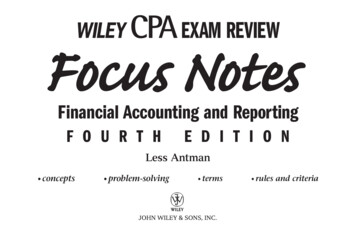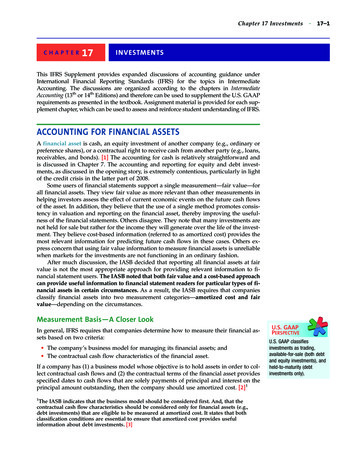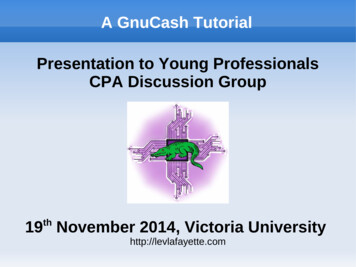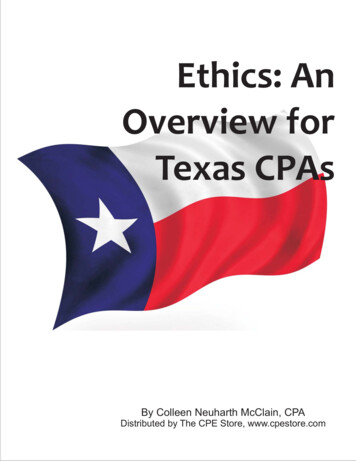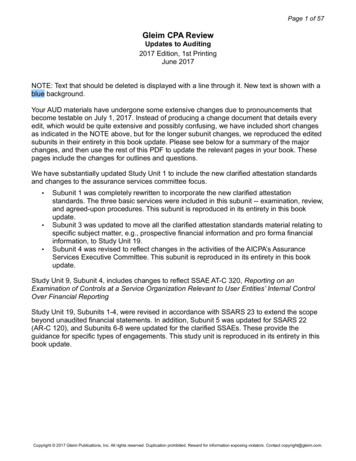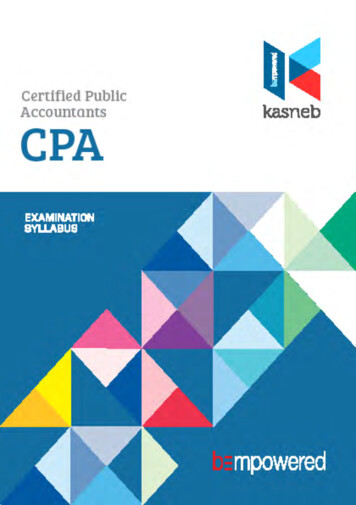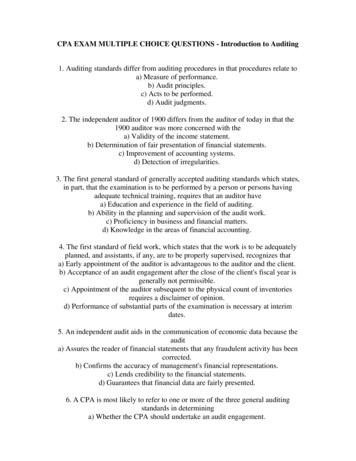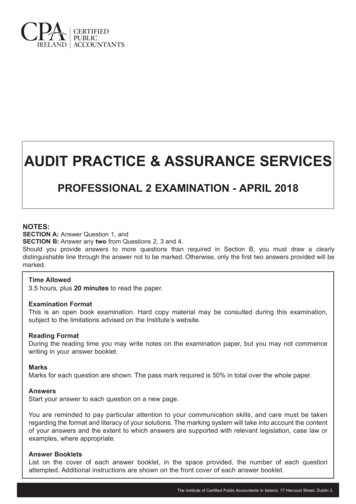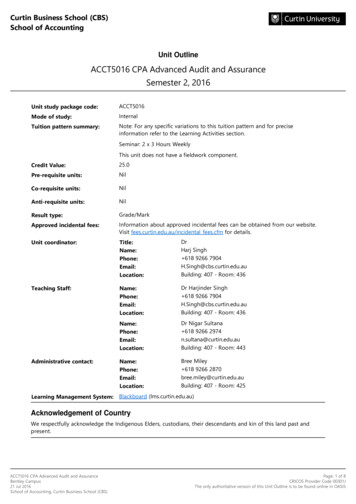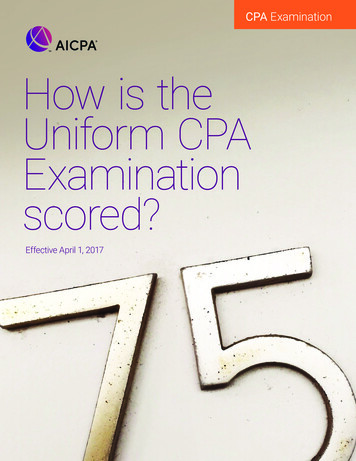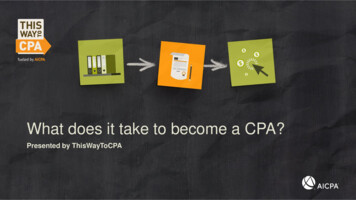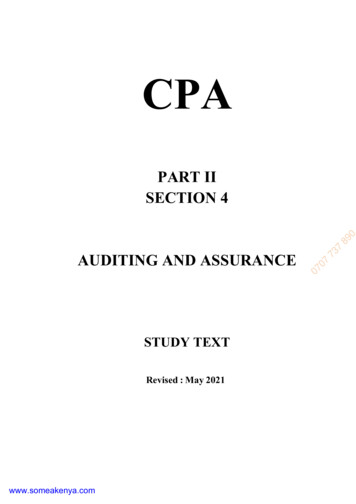
Transcription
CPASTUDY TEXTRevised : May 2021www.someakenya.com0707AUDITING AND ASSURANCE737890PART IISECTION 4
AUDITING AND ASSURANCECONTENT10.1-Assurance and non-assurance engagementsDefinition and objectivesElements of an assurance engagementTypes of assurance engagementsLevels of assurance and reportsNon-assurance engagements10.2 Nature and purpose of an audit- Nature and objectives- Audit as an assurance engagement- Development of audit (early audit and modern audit)- Types of audit and limitations89737070710.4 Planning and risk assessment- Obtaining, accepting and retention of an audit engagement- Understanding the entity and its environment- Audit planning, audit strategy, audit programmes and documentation- Assessing audit risks- Fraud, laws and regulations010.3 Audit Legal and Professional framework- Regulatory framework within which external audits take place- Statutory regulations; auditors' liability, appointment, removal, remuneration,resignation, rights and duties of auditors- International standards on auditing and other regulations- Professional ethics/code of ethics for professional accountants- Fundamental principles, threats and safeguards, other professional guidelines onaudit fees, conflict of interest, advertising and opinion shopping10.5 Overview of forensic accounting- Nature, purpose and scope of forensic accounting- Types of forensic investigations: Corruption, asset misappropriation, financialstatement fraud, others- Fraud prevention and deterrence10.6-Internal control systemsInternal controls theory and practiceThe use of evaluation of internal control system by auditorsTest controls on specific control environmentCommunication on internal control system (management letter)Information technology threats and controlPage 2www.someakenya.com
Overall audit reviewSubsequent events reviewGoing concern reviewContingencies and commitmentsManagement representationsQuality control and reviewAudit investigation10.9-Audit reportsLegal provisions on audit reportsBasic elements and key audit mattersTypes of audit reports and different aspects of reportingFeatures of audit reports10.10-Auditing in the Public SectorIntroduction to auditing in the Public Sector; regulatory provisionsFramework of public sector auditObjectives and scope of public sector auditCategories of public sector audit ( compliance audit, performance, financial)Audit report of auditor generalRole of internal audit function in public entitiesRelationship between external and internal auditors in the public sectorInternational Standards on Supreme Auditing Institutions10.118910.8-737Audit evidenceFinancial statement assertions and audit evidenceAudit evidence procedures/techniquesAudit sampling and other means of testingThe audit of specific items (income/expenses/assets/liabilities)Using the work of others (internal audit and experts)Computer assisted audit techniques070710.7-0AUDITING AND ASSURANCEEmerging issues and trendsPage 3www.someakenya.com
AUDITING AND ASSURANCECONTENTPAGE0707737890Topic 1: Assurance and non-Assurance engagements . . . .5Topic 2: Nature and purpose of an audit . 12Topic 3: Audit Legal and Professional framework . . . .31Topic 4: Planning and risk assessment 66Topic 5: Overview of forensic accounting .113Topic 6: Internal control systems . . .126Topic 7: Audit evidence . . . .139Topic 8: Overall audit review . . .193Topic 9: Audit reports . . 212Topic 10: Auditing in the Public Sector . . . .224Page 4www.someakenya.com
AUDITING AND ASSURANCETOPIC 1ASSURANCE AND NON-ASSURANCE ENGAGEMENTSDEFINITION AND OBJECTIVESThe term assurance refers to the expression of a conclusion that is intended to increase theconfidence that users can place in a given subject matter or information. For example, anauditor’s report is a conclusion that increases the confidence that users can place in acompany’s financial statements.0707737The auditor uses the term ‘audit engagement’ when the entity has to undergo the auditingprocedure. This could imply varied things and therefore it is necessary that the auditor clarifieswhat she/he exactly means by the term. Irrespective of the definition followed by the auditor,he/she makes it a point to follow certain specific guidelines and procedure for offering theservices.890Audit engagement refers to audit performed by an auditor. It is the very first stage of an auditprocedure where the client is notified by the auditor that the work pertaining to audit has beenaccepted by him/her and also provides clarifications with regard to the scope and purpose ofaudit. To be more specific, audit engagement can be referred to the written letter that theauditor uses to notify the client that he/she would be engaging in auditing services. Thus, theaudit engagement procedure is basically a negotiation based on professional terms that takesplace between prospective customer and a public accounting entity. This procedure is used forfinding new customers and offer accounting related services to different businesses.Full EngagementAudit engagement consists of several steps that basically revolve around planning,substantiation, control testing and finalization. The very first step involves providing a letter tothe client reminding him about the audit. Once the client has been contacts, both the auditorand client meet with each other to determine how, why and when the auditing would takeplace. In addition to this, the client also needs to provide the auditor with relevant resourcesfor conducting the procedure smoothly. Following this, the auditor carries out surveys to findout more about the organization and its controls. This is followed by testing of controls andgarnering of as much detail and information as is possible. On the basis of the results andinformation, the auditor prepares a temporary draft and shares the same with client. Once theclient has gone through the draft report, he responds to the recommendations and findingsmade in it. After this, the auditor prepares a final audit report and may also request the clientto fill a survey form to better understand his/her performance. The audit is completed after afollow up meeting with client, which usually happens within 6 months.Page 5www.someakenya.com
AUDITING AND ASSURANCEObjectives of the PractitionerA practitioner is an the individual(s) conducting the engagement (usually the engagementpartner or other members of the engagement team, or, as applicable, the firm) by applyingassurance skills and techniques to obtain reasonable assurance or limited assurance, asappropriate, about whether the subject matter information is free from material misstatementIn conducting an assurance engagement, the objectives of the practitioner are:a) To obtain either reasonable assurance or limited assurance, as appropriate, aboutwhether the subject matter information (that is, the reported outcome of themeasurement or evaluation of the underlying subject matter) is free from materialmisstatement;b) To express a conclusion regarding the outcome of the measurement or evaluation of theunderlying subject matter through a written report that clearly conveys eitherreasonable or limited assurance and describes the basis for the conclusion; andc) To communicate further as required by relevant ISAEs.890In all cases when .reasonable assurance or limited assurance, as appropriate, cannot beobtained and a qualified conclusion in the practitioner's assurance report is insufficient in thecircumstances for purposes of reporting to the intended users, the ISAEs require that thepractitioner disclaim a conclusion or withdraw (or resign) from the engagement, wherewithdrawal is possible under applicable laws or regulations.0707Non-assurance Engagements737NON-ASSURANCE ENGAGEMENTSIf an engagement lacks the five elements of assurance engagements, it is considered nonassurance (residual definition). Examples of non-assurance engagement are the following:1. Agreed-upon procedures2. Compilations engagements3. Preparation of Income tax returns where no conclusion conveying assurance isexpressed4. Management advisory services and Consulting5. Engagement that includes rendering of professional opinions not intended to be anassurance reportElements of Assurance EngagementsThere are five elements that must all be present in order to qualify the engagement as anassurance engagement.1. A three-party relationship involving a practitioner, a responsible party, and intendedusers;2. An appropriate subject matter;Page 6www.someakenya.com
AUDITING AND ASSURANCE3. Sufficient appropriate evidence;4. Suitable Criteria;5. A written assurance report in the form appropriate to a reasonable assuranceengagement or a limited assurance engagement.Appropriate Subject MatterThe subject matter and the subject matter information of an assurance engagement can takemany forms, such as: Financial performance or conditionsNon-financial performance or conditionsPhysical characteristicsSystems and ProcessesBehaviorSufficient Appropriate Evidence 0707737 Identifiable and capable of consistent evaluation or measurement against the identifiedcriteriaCapable of being subjected to procedures for gathering sufficient appropriate evidenceto support a reasonable assurance or limited assurance conclusion, as appropriate89 0An appropriate subject matter isSufficiency is the measure of the quantity of evidenceo The quantity of evidence needed is affected by the risk of the subject matterbeing materially misstated.Appropriateness is the measure of the quality of evidence, that is, its relevance andreliabilityo The reliability of evidence is influenced by its source and by its nature, and isdependent on the individual circumstances under which it is obtained.o Generalization about the reliability of evidence – evidence is more reliable if: Obtain from independent source outside the entity Generated internally when the related controls are effective Obtained directly by the practitioner than indirect or by inference Exist in documentary form Provided by original documentsMerely obtaining more evidence may not compensate for its poor qualityThe auditor should consider the cost of obtaining the usefulness of the evidence.Page 7www.someakenya.com
AUDITING AND ASSURANCESuitable CriteriaThe following are the characteristics of a criteria to be considered suitable: Relevance – contribute to conclusions that assist decision-making by the intendedusers. Completeness – the relevant factors that could affect the conclusions are not omitted.Includes benchmarks for presentation and disclosure Reliability – allows reasonably consistent evaluation or measurement of the subjectmatter including where relevant, presentation and disclosure, when used in similarcircumstances by similarly qualified practitioners Neutrality – free from bias Understandability – contribute to conclusions that are clear, comprehensive, and notsubject to significantly different interpretations0707897371. As to level of assurance:i. Reasonable Assurance – the objective is a reduction in assurance engagementrisk to an acceptably low level as the basis for a positive form of expression of apractitioner’s conclusion. (e.g., audit of historical financial statements)ii. Limited Assurance – the objective is a reduction in assurance engagement riskto a level that is acceptable in the circumstances of the engagement, but wherethe risk is greater that for a reasonable assurance engagement, as the basis for anegative form of expression of the practitioner’s conclusion. (e.g., review ofhistorical financial statements2. As to structure of engagement:i. Assertion-based – the evaluation or measurement of the subject matter isperformed by the responsible party, and the subject matter information is in theform of assertion to the intended users.ii. Direct Reporting – the practitioner either directly performs the evaluation ormeasurement of the subject matter, or obtains a representation from theresponsible party that has performed the evaluation or measurement that is notavailable to intended users. The subject matter information is provided to theintended users in the assurance report.0TYPES OF ASSURANCE ENGAGEMENTSImportance of Assurance Engagements1.2.3.4.Potential bias in providing informationRemoteness between a user and the organizationComplexity of the transactions, information, or processing systemsInvestors need to manage their risk and thereby minimize financial surprises asconsequences to investors, and others, of relying on inaccurate information can be quitesignificant.Page 8www.someakenya.com
Audit engagement refers to audit performed by an auditor. It is the very first stage of an audit procedure where the client is notified by the auditor that the work pertaining to audit has been accepted by him/her and also provides clarifications with regard to the scope and purpose of audit. To be more specific, audit engagement can be referred to the written letter that the
